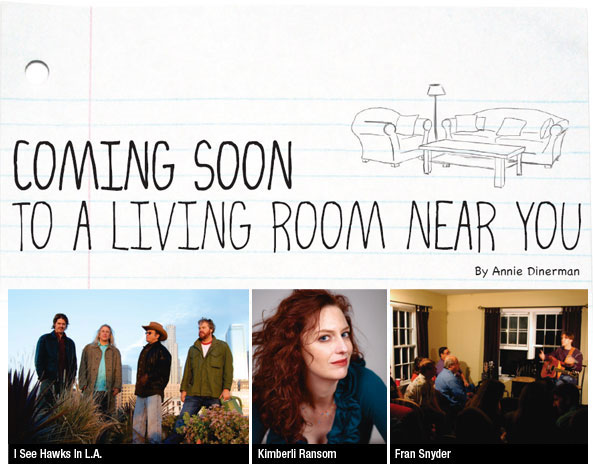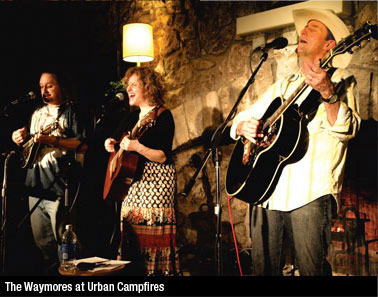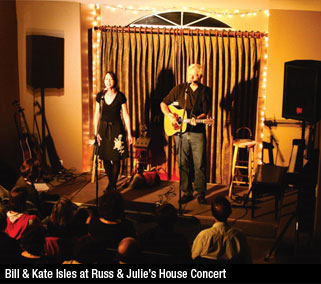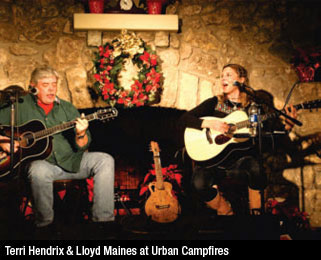
| PHOTO CREDITS: |
| I See Hawks In L.A. Courtesy of I See Hawks In L.A. |
| Kimberli Ransom Courtesy of Kimberli Ransom |
| Fran Snyder Ryan Simmons |
| The Waymores Ken Erfurth |
| Bill & Kate Isles Courtesy of Russ and Julie Paris |
| Terri Hendrix & Lloyd Maines Ken Erfurth |
by Annie Dinerman
Imagine your favorite musician singing and playing in your living room for you and your friends. It’s an old tradition; from Colonial days into the 1940s, Americans hosted “home musicales,” where talented musicians entertained friends and family in the parlor. As children, Dolly Parton and Judy Collins sang at home musicales. For today’s folk, country and roots artists, and for music fans, the solution to the Recession may be a house concert.
Today’s music lovers invite people they know to hear live music in their homes. Guests’ suggested donations, usually $15-20, go to the musician, with some attendees opting to pay more. With little or no sound system and no stage per se, the audience witnesses personal performances. Over a potluck supper during a break or after the performance, guests purchase CDs signed by musicians like master string player of the Nitty Gritty Dirt Band, John McEuen. “Something about it harkens back to a time where you were up close to people and the fourth wall was broken a little more,” McEuen said.
Would Ray Wylie Hubbard, whose latest CD was nominated for an Americana Music Association award, want your desk lamp for his spotlight? Actually, yes. Silent crowds lean in to hear his literate outlaw lyrics at about six packed house concerts annually. He describes the familiar hush as “this kind of a unique, underground, cool secret that’s going on.”
 Paul Lacques, lead guitarist for I See Hawks In L.A., whose music references love, ecology, peace and pot feels a smaller room, where the barrier between band and audience dissolves, suits the band. “Probably the smaller, the better, ironically enough,” Lacques said. “My favorite ones have been when people just pack into a little room, probably 75 people.” Janet Hans, co-host of Urban Campfires, a 20-year-old San Antonio, TX house concert series, said in most cases the audience could reach out and strum the guitar.
Paul Lacques, lead guitarist for I See Hawks In L.A., whose music references love, ecology, peace and pot feels a smaller room, where the barrier between band and audience dissolves, suits the band. “Probably the smaller, the better, ironically enough,” Lacques said. “My favorite ones have been when people just pack into a little room, probably 75 people.” Janet Hans, co-host of Urban Campfires, a 20-year-old San Antonio, TX house concert series, said in most cases the audience could reach out and strum the guitar.
“We average 55 to 60 people,” said Julie Paris, co-host of Russ & Julie’s House Concerts in Oak Park, CA. “We consider 80 to be a full room.” She emails artists a week ahead about reservations. “We ask $15 per person at the door. 100 percent of that money goes to the artist,” she said. In their 13th year, they’re booking more double bills. The audience gets two acts; the acts split the money but play for more people, and it helps gifted artists survive.
In the 1960s, there were many acoustic clubs where Americans shared the rich social values surrounding live music. “In this technological age a live show is one of the last places a musician can earn a living,” Lacques said. “The free download culture has kind of licked our record sales.” McEuen clears as much as $3,500 at a house concert, “equivalent to about an $8,000 road day… and there is nothing wrong with reaching 75 to 100 people, as opposed to thousands.” Urban Campfires helps artists make a living. “If we don’t pay these artists to do their work, they’re not going to be able to afford to do it anymore and we’re going to be the losers,” Hans said.
Performers who fill clubs and get airplay also do house concerts, including Jim Messina of Loggins and Messina. Levon Helm, former drummer of the Band, who once rocked Bob Dylan’s first electric tour, today, hosts the Midnight Ramble, at his Woodstock, NY, home, which McEuen calls “the Carnegie Hall of house concerts.”
Good singers know how to make themselves heard, so many house concerts don’t have a PA system, though some have added other amenities. Russ and Julie Paris, who have hosted concerts since 1996, installed track lights. “We went out and purchased some professional quality gels to put over those lights,” Julie Paris said. “But we turn the lights down so that the focus is on the performer and the performance.”
 Typically, the audience sits on rented folding chairs, or their own pillows. A dining table presents a potluck buffet. Don’t be surprised to find the sink or bathtub used as an ice bucket, and coats hung on a shower rod. Guests can go green and bring their own plates and cups. Friends move chairs, hang coats, collect donations and check off the reservation list.
Typically, the audience sits on rented folding chairs, or their own pillows. A dining table presents a potluck buffet. Don’t be surprised to find the sink or bathtub used as an ice bucket, and coats hung on a shower rod. Guests can go green and bring their own plates and cups. Friends move chairs, hang coats, collect donations and check off the reservation list.
Hosts enjoy special perks. “Hosts don’t have to leave home,” Terry Garthwaite, of the ’60s Berkeley band Joy Of Cooking, said. “Each concert is an advertisement for the next. Hosts become visible, and get to deal personally with the artists.” Songwriter Tom Boyd has hosted Music Over Manhattan for two years in his New York City loft, and feels like the luckiest guy in the neighborhood. “Great music, a room full of friends, and I don’t have to drive home.”
Sometimes, the road leads back home. Russ and Julie Paris were excited to book Congressman John Hall on a double bill with bassist Freebo. Hall, who wrote the hits “Still The One” and “Dance With Me” for his band Orleans, and Freebo, who’s toured with Bonnie Raitt, toured together long ago, but the men had lost touch. This house concert reunion led to a new tour, and they returned a year later to Russ and Julie’s.
Success can depend on details: Do the neighbors know there will be extra cars parked on the block? Hosts stick to music they love and openly share their enthusiasm. Philadelphia folk duo Kim and Reggie Harris perform a rich variety of traditional African-American songs at house concerts. “House concerts are making inroads, helping people to invite music that they want, or make, back into the home,” Reggie Harris said.
 After Fran Snyder performed his first house concert, he searched online for another audience connection for his original, lyric-oriented, guitar-driven pop. “I quickly became infuriated with the high percentage of out-of-date and flatout-wrong information regarding house concerts,” he said. Someone needs to fix this, he thought, and created a how-to Web site, ConcertsInYourHome.com. There, anyone interested can network, view videos, subscribe to a newsletter, request a free compilation CD and get answers.
After Fran Snyder performed his first house concert, he searched online for another audience connection for his original, lyric-oriented, guitar-driven pop. “I quickly became infuriated with the high percentage of out-of-date and flatout-wrong information regarding house concerts,” he said. Someone needs to fix this, he thought, and created a how-to Web site, ConcertsInYourHome.com. There, anyone interested can network, view videos, subscribe to a newsletter, request a free compilation CD and get answers.
To build the right audience, Boyd relies on a list of several hundred people he has met at house concerts or through songwriter associations. “For me, it’s a bit of a balancing act, because I want to turn strangers into friends of the music, too,” he said. That process is a two-way street, according to Kimberli Ransom, a Portland, OR, pop-rock-folk artist. “It’s the artist’s responsibility to educate the host on what their music is about, what kind of show they’re going to put on,” she said. “It’s the host’s responsibility to look through their friends and family to choose and invite those people.”
Ransom created her first Word Of Mouth Tour, in 1997, by emailing friends. “Most of my hosts had never heard of a house concert before,” she said. “People who had seen me in shows called their cousin in Detroit and said, ‘You should do this.’ It was a real niche. People wanted to be connected.” With Douglas McLeod, she co-wrote House Concerts, A Guide For Musicians And Hosts, a useful memoir and guide for artists and hosts.
Onstage, Ransom introduced original songs with personal stories, especially about being adopted. “Lots of people around the country came up and told me their adoption stories,” she said. “Somebody had posted a comment [online], ‘Kimberli Ransom, if you ever read this, know that I found my birth daughter.’ ” Ransom has opened shows for Dan Fogelberg in front of 3,000 people. “I don’t know anybody who went to those shows,” she said. “But I know the people who went to my house concerts.”



Be the first to comment!